The Intel Core Ultra 7 155H Review: Meteor Lake Marks A Fresh Start To Mobile CPUs
by Gavin Bonshor on April 11, 2024 8:30 AM ESTASUS Zenbook 14 OLED UX3405MA: Power, System & Storage Performance
As we did in our review of the Razer Blade 14 (2023) gaming notebook, we're also including a pair of desktop chips in our comparison. This includes the AMD Ryzen 7 8700G and Ryzen 5 8600G, which are APUs and are actually based on AMD's Phoenix mobile architecture. This relates to our testing of the AMD Ryzen 9 7940HS, which includes the same Radeon 780M integrated graphics. However, the Ryzen 8000G APUs are adopted for desktops. This allows us to show more data points for our review of Intel's Meteor Lake-based Core Ultra 7 155H to see where performance lies.
Despite including AMD's Phoenix-based Ryzen 8000G APUs in our results, as we expand our list of notebooks tested, we'll have more effective and comparable data points in the future. To add more reference, all of the chips have been tested with Windows 11 22H2.
Power
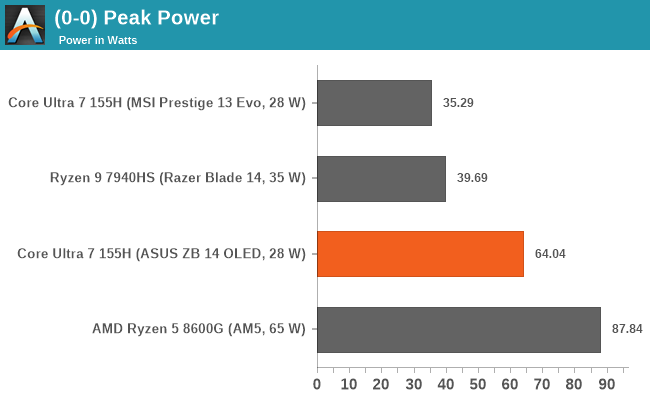
We can see that the peak power value on the Intel Core Ultra 7 155H-equipped ASUS laptop hits just below 65 W, which is Intel's minimum assured power (MAP) value for this specific chip. Although the Intel Core Ultra 7 155H has a maximum turbo TDP of 115 W, which is entirely dependent on the mobile manufacturer to implement, and such is the case of the ASUS Zenbook 14 OLED UX3405MA ultrabook, it is too thin and light on cooling to be able to cater to such high power draw. For the purposes of this review, we've limited the Ryzen 9 7940HS to its base TDP of 35 W, which means there will be some variance depending on the workload, which can range up to 39 W.
We can see something very interesting by looking more in-depth at the Intel Core Ultra 7 155H power within the ASUS Zenbook 14 OLED. Using the latest CineBench 2024 rendering benchmark on a loop with the multi-threaded test selected, we can see that the Core Ultra 7 155H hits thermal and power throttling very quickly. Within five seconds of the start of the benchmark, the Core Ultra 7 155H peaks around 64-65 W. It then quickly ramps down to between 28 and 30 W, which is around the base TDP of the chip, which Intel rates at 28 W. This means the chip is throttling by more than half of the 65 W maximum assured power rating Intel has given this chip.
Another thing we can see from our power testing is that the Ryzen 9 7940HS, at the default settings, operates at a higher power than the Core Ultra 7 155H over a prolonged period. To make performance comparisons fairer where we can, we put the Razer Blade 14 into silent mode, which reduced the power of the Ryzen 9 7940HS down to around 39 W for sustained load. This chip isn't overclockable, so there's no viable way to control power consumption.

Using the low power mode, which ASUS officially calls 'whisper mode' on the ASUS Zenbook 14 OLED, we can see this reduces power massively with a peak of 19 W before settling quickly to a consistent 14-15 W range. As we can see in the above Blender 3.6 data, the whisper mode and a lower power profile applied to the Core Ultra 7 155H prove ineffective regarding workload performance. The Ryzen 7940HS also exhibits similar behavior in multi-threaded workloads, peaking at 45 W before quickly settling down to a very consistent mark of around 38-39 W throughout the benchmark.
Ultimately, this helps to properly characterize the power characteristics of our sample laptops. While both the Intel and AMD chips have overlapping TDPs, the Razer Blade that the Ryzen chip sits in is very clearly built and tuned for higher sustained power than the thin-and-light ASUS ultrabook. So we never have an entirely apples-to-apples testing scenario, though short of putting both chips in the same chassis, that would always be the case. That being said, we have tried to limit the power on the Ryzen 9 7940HS to its base TDP of 35 W, just to make things a little more fairer.
As for the Zenbook in particular, this tells us that its cooling isn't enough to provide enough capability to sustain high power in multi-threaded workloads, at least not in line with Intel's 65 W value for maximum assured power. While it's true that different types of workloads are more intensive than others, and CineBench 2024 MT is considered a heavy test, we're effectively showing the worst-case scenario here for the Core Ultra 7 155H. That means that results may vary in different multi-threaded workloads and with different models of notebooks with different levels of cooling.
Looking at single-threaded power consumption in CineBench 2024, the Core Ultra 7 155H peaks at around 43 W before ramping down to a semi-consistent power range of between 27 and 30 W. The AMD Ryzen 9 7940HS is more power efficient than Intel's Meteor Lake architecture in single-threaded performance, with a quick ramp up to around 41 W and then an ultra-consistent value of between 23 and 24 W. How that translates into performance in our benchmark suite for 2024 shapes up to be a battle of Intel's Core Ultra 7 155H at a sustained 28 W, versus the AMD Ryzen 9 7940HS that we forced to run at base TDP (35 W) at around 29 W in single-threaded applications.
Web & Office
The next section of our updated notebook test suite is web and office-based tests. Our updated notebook suite runs in parallel with our current CPU test suite for 2023. It allows us to blend mobile chips tested with desktop chips, mainly to see efficiency and performance levels and how they stack up for each generation we try.
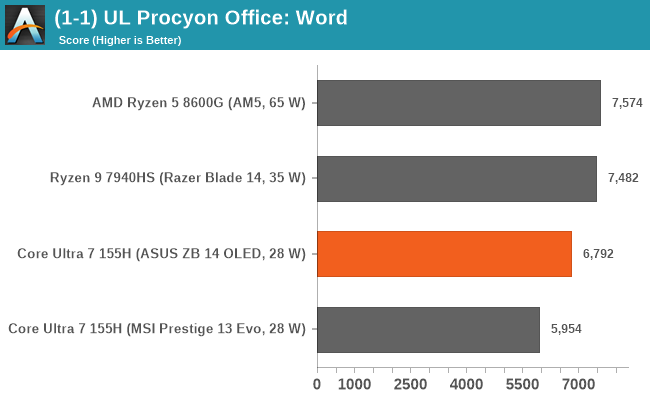
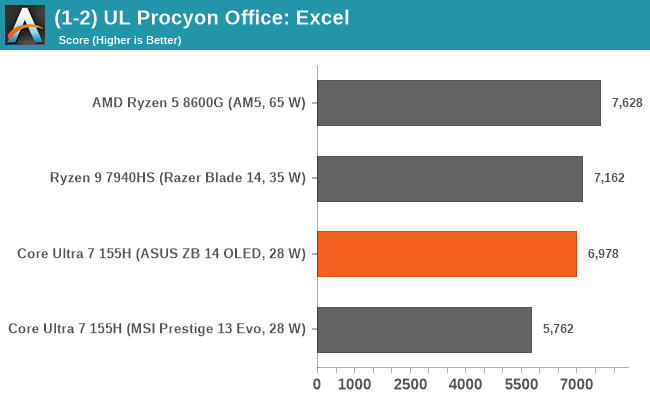
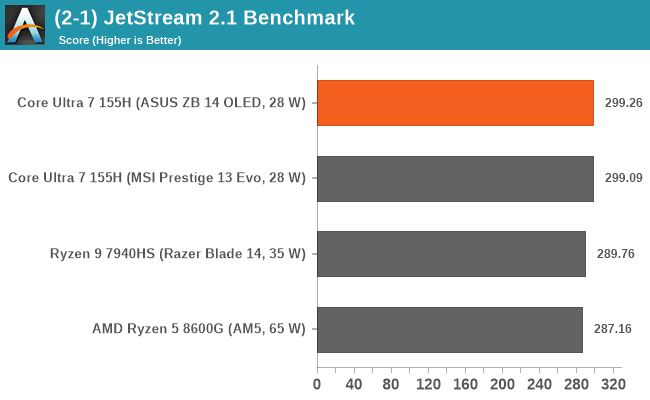
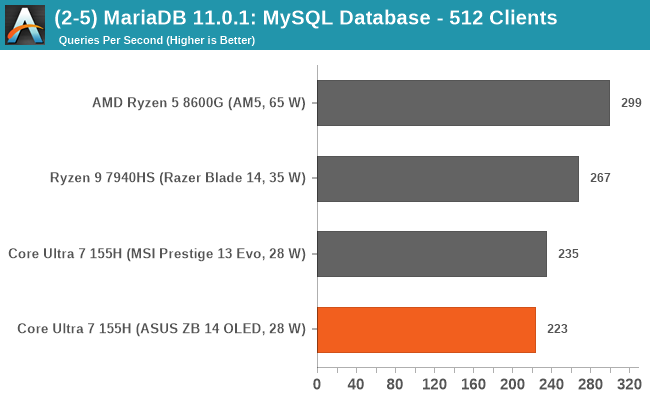
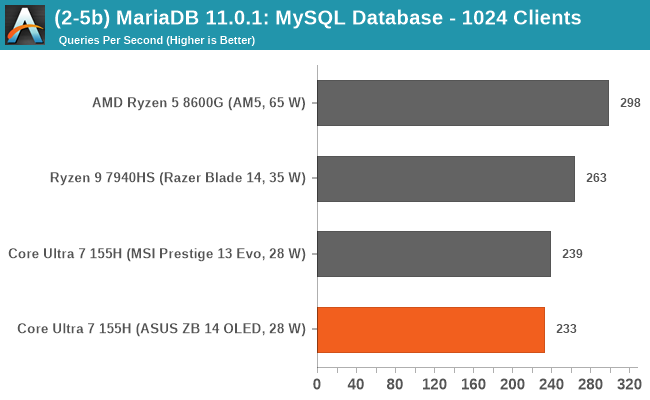
Looking at performance in our web and office-based testing, in the UL Procyon Office-based tests using Microsoft Office, the Core Ultra 7 155H is competitive but lags behind the AMD chips slightly. Meteor Lake does very well in the web-based Jetstream 2.1 benchmark, even outperforming the desktop-based Ryzen 8000G APU pairing. We see a different story in our MariaDB MySQL database benchmarks, although performance is still relatively competitive compared to the AMD chips we've tested.
Storage
Storage performance is dictated by more than just putting in the fastest drive you can; other variables include the interface used, the quality of the controller, and the overall drive. The ASUS Zenbook 14 OLED UX3405MA includes a 1 TB drive, which is labeled as a Western Digital WD560 NVMe drive. It has a PCIe 4.0 x2 interface, which means its performance is similar to that of a PCIe 3.0 x 4 M.2 drive.
Unfortunately, we couldn't find any official specifications for the Western Digital WD560 NVMe SSD. However, as we can see in CrystalDiskMark, we are seeing sequential read speeds of just under 5000 MB/s with sequential write performance of around 3300 MB/s. This is still good raw throughput performance for an ultrabook such as the ASUS Zenbook 14 UX3405MA, although this will differ between both compressed and uncompressed data.
When judging and measuring storage performance, it comes down to real-world performance and ensuring optimal cooling, especially on these fast NVMe drives, which can run very hot and thermally throttle, reducing performance.

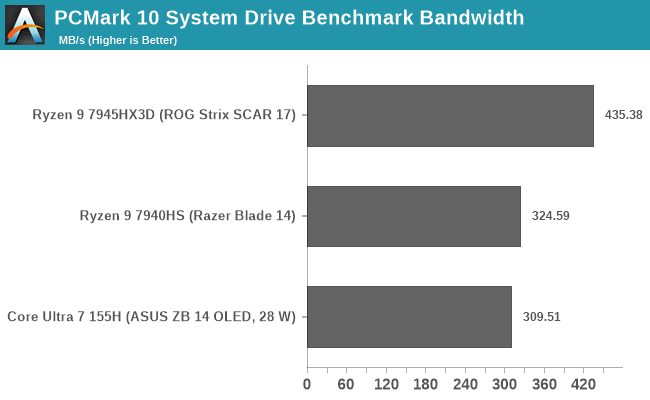
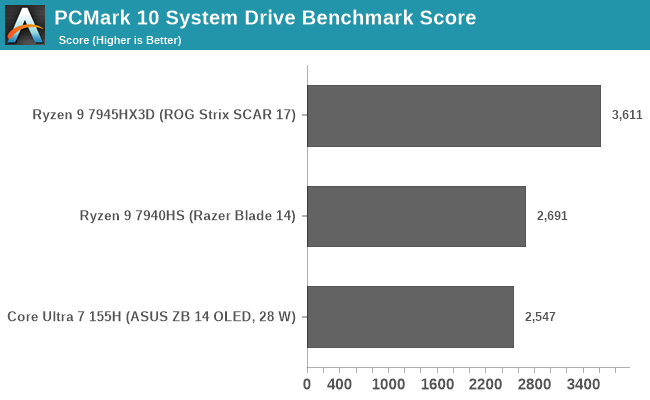
Using the storage benchmark built into PCMark 10, we can see that the ASUS Zenbook 14 UX3405 and the WD560 1 TB SSD being used are somewhat inferior to drives in other similar notebooks we've tested. For storage, we've included the ASUS ROG Strix SCAR 17, which is a desktop replacement model and ultimately has the best-in-class storage it can accommodate.
Even compared to the MSI Prestige 13 AI Evo A1MG notebook, which also has an Intel Meteor Lake Core Ultra 7 155H installed, the storage performance of the ASUS Zenbook 14 OLED isn't up to the same level.


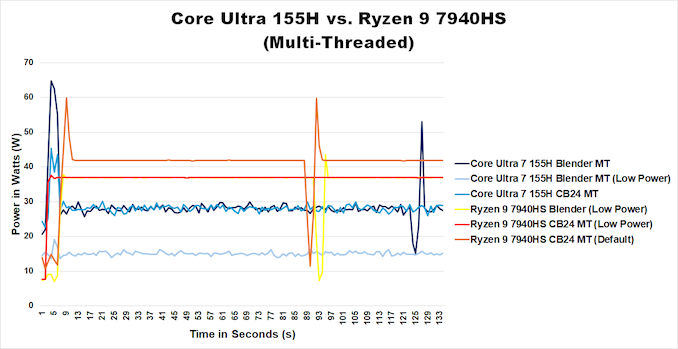
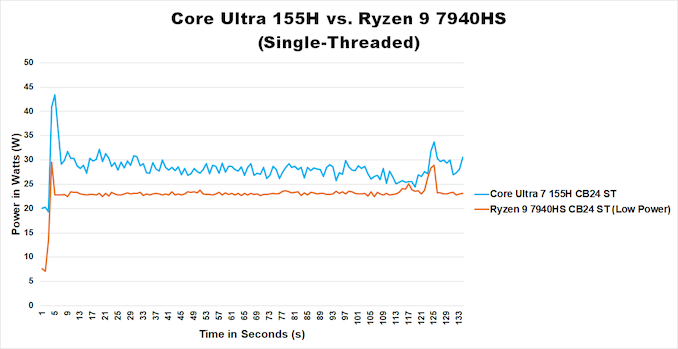









69 Comments
View All Comments
lmcd - Wednesday, April 17, 2024 - link
That GloFo combo for Zen 2 and 3 never made it to an efficient mobile platform (HX technically exists but whatever).Intel 4 is an incomplete node. Intel 3 had better fix a lot of the issues because at this point, Intel's best bet looks like an entirely-TSMC SoC. Reply
James5mith - Friday, April 12, 2024 - link
"Meanwhile AMD does not offer a custom execution backend for this test, so while Windows ML is available as a fallback option to access the CPU and the GPU, it does not have access to AMD's NPU."So why are there no graph entries for the AMD GPU using Windows ML? You only show CPU results in the graph. Seems a bit disingenuous. Reply
Tams80 - Friday, April 12, 2024 - link
This is really a rather pathetic comparison. YouTubers can get their hands on more devices for comparison than this.I get it. AnandTech is a dying publication that doesn't have the influence it used to, to get devices. And this also leads to particularly fluffy pieces to appease the few companies that do provide review units. Reply
The Von Matrices - Friday, April 12, 2024 - link
How can a PCIe 4.0 x2 disk have a read speed of 5GB/s? The bus only has a transfer rate of 4GB/s. Replyskavi - Saturday, April 13, 2024 - link
> Starting with the Redwood Cove (P) core cluster on the Core Ultra 7 155H, we can see that the core-to-core access latencies across the P-cores ranges from 4.5 to 4.9 ns, which is very similar to that of Raptor Lake via the Core i5-14600K, which sits between 4.6 and 4.9 ns; this indicates that both have the same P-core topology.By core to core, you mean intercore, right? or hyperthread to hyperthread?
> For the E-cores, the latencies shoot up to between 57.9 and 74.8 ns per each L1 access point, with the two first E-cores having a latency of just 5.0 ns.
Am I going crazy? It seems obvious to me those “two first E-cores” are a single P-core. Reply
jpvalverde85 - Tuesday, April 16, 2024 - link
AI compute capability is just there, then the big cores are just good enough against Zen4, the IGP just as strong on the best scenario (drivers can get the better out of it but still weak on some titles), now overall if we cut IA outside, Meteor Lake gets spanked badly by a gen old Ryzen. The good is that everything seems to work even coming in different tiles for being a tech demo, but i suspect that the BOM of the Ryzen 9 7940HS is lower being a monolithic 180mm2 design, Intel probably had to spent a lot of "glue" per mm2 of silicon. Replylmcd - Wednesday, April 17, 2024 - link
The glue might not be cheap but TSMC 6nm sure is, and 5nm isn't wildly expensive either.This Intel 4 tile though is clearly so far from finished. This is a horrifying showing for Intel Foundry's fab capabilities even if their packaging is clearly fantastic. And we are so overdue for the current larger cores to get dropped and the design roadmap for Atom forked into a large and small core. Reply
shady28 - Wednesday, April 17, 2024 - link
Like other mentioned, these aren't comparable products.That really shows up when you look at the battery life comparisons. The 155H has a 75W-H batter vs 69W-H on the 7940HS, 9% more capacity. Yet it lasts 95% longer in the rundown test.
That's going to show up in performance too.
HotHardware has a much better comparison, a 165H against comparable products like the 7736U and Z1 Extreme (30W TDP), as well as last gen RL 1365U (15W / 55 max).
The 165H had the longest battery life in their test of any machine tested, 1/3 more than the Z1 Extreme. Reply
kkilobyte - Wednesday, April 24, 2024 - link
Have the SPEC2017 tests been adapted? The text still says to this day that the results will be adapted when they are available. Reply